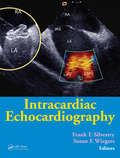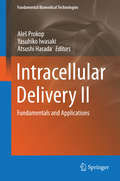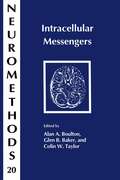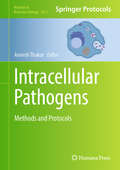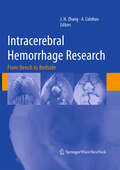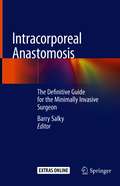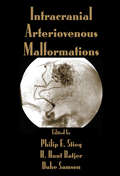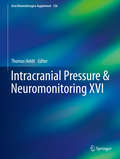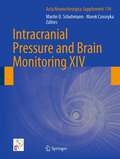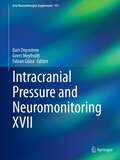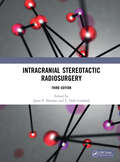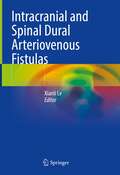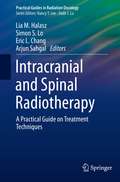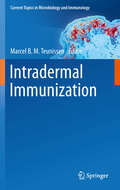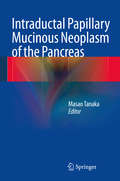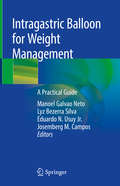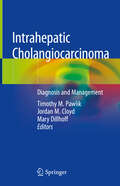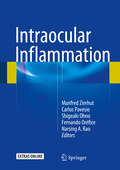- Table View
- List View
Intracardiac Echocardiography
by Susan E. Wiegers Frank E. SilvestryIntracardiac Echocardiography is the first echocardiographic textbook of its kind to specifically cover ICE. Discussing all aspects of intracardiac ultrasound, it allows readers to perfect ICE image acquisition and helps to guide interpretation of this information during interventional and electrophysiologic procedures.Unique and informative, the text explores:introductory echo physics currently available intracardiac ultrasound systems basic image acquisitionthe role of ICE in both the interventional and electrophysiology laboratory, as well as in the diagnostic setting. Featuring expert commentary by leaders in the field, the book also includes high quality echocardiographic images illustrating how ICE is used in a wide variety of procedures such as transseptal catheterization, PFO and ASD closure, atrial fibrillation ablation procedures, and many others.
Intracellular Delivery II
by Aleš Prokop Yasuhiko Iwasaki Atsushi HaradaThis volume is a continuation of Volume 1 following the previously published Editorial. More emphasis is given to novel nanocarrier designs, their characterization and function, and applications for drug discovery and treatment. A number of chapters will deal with nanofibers as a new major application within the biomedical field with a very high success rate particularly in wound healing and diabetic foot and spine injuries. A major new subdivision will deal with mathematical methods for the assembly of nanocarriers both for simulation and function.
Intracellular Delivery III
by Volkmar Weissig Aleš ProkopThis book features a special subsection of Nanomedicine, an application of nanotechnology to achieve breakthroughs in healthcare. It exploits the improved and often novel physical, chemical and biological properties of materials only existent at the nanometer scale. As a consequence of small scale, nanosystems in most cases are efficiently taken up by cells and appear to act at the intracellular level. Nanotechnology has the potential to improve diagnosis, treatment and follow-up of diseases, and includes targeted drug delivery and regenerative medicine; it creates new tools and methods that impact significantly existing conservative practices. This volume is a collection of authoritative reviews concentrating on cellular and organelle delivery and targeting, and ways of identifying targets by biochemical and computational means.
Intracellular Messengers
by Alan A. Boulton Glen B. Baker Colin W. TaylorThis timely new volume in the highly acclaimed Neuromethods series focuses on major new advances in understanding the signaling mechanisms employed by neural tissues. Chapters, contributed by experts in the field, provide thorough, up-to-date coverage of a variety of topics and techniques, including: single-cell imaging technology * phosphorylation of target proteins * analysis of phosphoinositides and inositol phosphates * inositol trisphosphate and intracellular calcium * guanine nucleotide-binding proteins * ion channel gating * measurement of intracellular calcium with fluorescent calcium indicators * protein kinase C * synthetic analogs of intracellular messengers * cyclic nucleotides * caged intracellular messengers * intracellular regulators and components of the exocytotic pathway * intracellular messengers in vertebrate and invertebrate photoreceptors. Neuromethods 20 * Intracellular Messengers is an essential resource for neurobiologiests at all levels of research.
Intracellular Pathogens: Methods and Protocols (Methods in Molecular Biology #2813)
by Aneesh ThakurThis detailed volume presents cutting-edge approaches to study infection, immunity, and intervention strategies against intracellular pathogens. The book explores areas such as how intracellular pathogens infect and survive inside the phagocytes, immunopathological features of infection, evasion of host-induced immune responses, cellular crosstalk in the presence of intracellular pathogens, host innate and adaptive immunity, and much more. Written for the highly successful Methods in Molecular Biology series, chapters include introductions to their respective topics, lists of the necessary materials and reagents, step-by-step and readily reproducible laboratory protocols, and tips on troubleshooting and avoiding known pitfalls. Authoritative and practical, Intracellular Pathogens: Methods and Protocols serves as an ideal guide for researchers who work with intracellular pathogens and want to utilize or refine strategies to study, treat, or controlthem.
Intracellular Signaling Mediators in the Circulatory and Ventilatory Systems
by Marc ThirietThe volumes in this authoritative series present a multidisciplinary approach to modeling and simulation of flows in the cardiovascular and ventilatory systems, especially multiscale modeling and coupled simulations. The cardiovascular and respiratory systems are tightly coupled, as their primary function is to supply oxygen to and remove carbon dioxide from the body's cells. Because physiological conduits have deformable and reactive walls, macroscopic flow behavior and prediction must be coupled to phenomenological models of nano- and microscopic events in a corrector scheme of regulated mechanisms when the vessel lumen caliber varies markedly. Therefore, investigation of flows of blood and air in physiological conduits requires an understanding of the biology, chemistry, and physics of these systems together with the mathematical tools to describe their functioning. Volume 4 is devoted to major sets of intracellular mediators that transmit signals upon stimulation of cell-surface receptors. Activation of signaling effectors triggers the release of substances stored in cellular organelles and/or gene transcription and protein synthesis. Complex stages of cell signaling can be studied using proper mathematical models, once the role of each component is carefully handled. Volume 4 also reviews various categories of cytosolic and/or nuclear mediators and illustrates some major signal transduction pathways, such as NFkappaB axis, oxygen sensing, and mechanotransduction.
Intracerebral Hemorrhage
by J. Ricardo Carhuapoma Stephan A. Mayer Daniel F. HanleyIntracerebral hemorrhage is a neurovascular emergency associated with high mortality and morbidity. With in-depth reviews of the clinical and biological aspects of the condition, this text provides an up-to-date coverage of this form of stroke. The book covers epidemiology, causes, clinical presentation, management and prognosis, and describes the ongoing research advances aimed at improving our understanding of the condition. The book fills an existing gap in the medical literature. The chapters discussing the clinical aspects of intracerebral hemorrhage are aimed at the practitioner directing the care of stroke victims. Chapters exploring the biology of pathophysiological events triggered by this disease will provide readers with current data directed to facilitate experimental research in this field of cerebrovascular neurology. It will appeal to clinicians and those with a research interest in cerebrovascular diseases.
Intracerebral Hemorrhage Research
by Austin Colohan John ZhangThe volume includes 75 papers which were presented at the Third International Conference on Intracerebral Hemorrhage, held in Rancho Mirage, California, in March 2010. The topics treated include animal models, pathophysiology of cerebral hemorrhage, experimental treatment for cerebral hemorrhage, cerebral hemorrhage clinical manifestations, prognosis of cerebral hemorrhage, and clinical management. The articles represent the recent advances in hemorrhagic brain injury research presented by highly respected laboratories around the world.
Intracorporeal Anastomosis: The Definitive Guide for the Minimally Invasive Surgeon
by Barry SalkyLaparoscopic and robotic approaches to colon, rectum and the small intestine have undergone radical change since the introduction of minimally invasive surgical techniques. At the beginning of this revolution, the most common anastomotic techniques have been extracorporeal. As a few surgeons became more familiar with minimally invasive suturing techniques, intracorporeal anastomosis became possible. However, the change from an extracorporeal approach has been slow to realization for the vast majority of surgeons. While there are multiple reasons for this slow adoption, the most common are perceived difficulty with suturing in a closed space, the feeling of lack of control, and the worry of increased infection in the abdomen. This book details the latest information in addressing and dispelling these fears. It provides a useful guide to techniques required to perform intracorporeal anastomoses both in laparoscopic and robotic surgery, and it shows the huge advantages to the patient, surgeon and to our health care system. Written by experts in the field, chapters serve as a definitive guide to the performance of intracorporeal techniques to all general and colon and rectal surgeons performing bowel resection both for benign and malignant disease. The chapters contain ample color photographs and videos describing each technique.Intracorporeal Anastomosis primarily focuses on laparoscopic and robotic techniques and contains the latest published data describing the advantages of using these minimally invasive surgical techniques.
Intracranial Arteriovenous Malformations
by Philip E. Stieg H. Hunt BatjerOffering expert recommendations and selected color illustrations, this guide furnishes readers with state-of-the-art information on the pathophysiology, diagnosis, evaluation, and treatment of AVMs. Offering a multidisciplinary approach, this book spans a wide array of therapeutic options and surgical approaches with step-by-step presentations of e
Intracranial EEG: A Guide for Cognitive Neuroscientists (Studies in Neuroscience, Psychology and Behavioral Economics)
by Nikolai AxmacherThis book offers the first, comprehensive guide to planning and conducting intracranial EEG studies, and analyzing intracranial EEG data. The chapters address core questions in the field of intracranial EEG research. They are written by internationally recognized experts in the domain of intracranial EEG and acknowledge the heterogeneity of approaches in this field. The particular format of the book allows readers to find clear guidelines, hands-on expertise and invaluable background information for planning and conducting state-of-the-art intracranial EEG research projects. Besides offering a reference guide to newcomers in the field, it also provides scholarly information for the more experienced researcher and inspiration for the expert. The book covers a wide range of topics, with a special emphasis on aspects in which intracranial EEG data differ from other types of data in the cognitive neurosciences. It discusses typical patient characteristics and implantation schemes, ethical issues, and practical considerations for planning and running intracranial EEG experiments. It addresses signal characteristics and the physiological background of oscillatory and non-oscillatory aspects of intracranial EEG signals. It describes complex pre-processing steps such as advantages and disadvantages of different referencing schemes, and how to identify the location of electrodes. In addition, it answers specific questions on data processing, addressing core aspects of statistical analysis, and suggesting guidelines for data presentation. Further, it covers advanced topics such as causal interventions (i.e. deep brain stimulation), acquisition and analysis of single-unit data and multimodal recordings, and discusses important future challenges and opportunities in the field of intracranial EEG research.
Intracranial Pressure & Neuromonitoring XVI (Acta Neurochirurgica Supplement #126)
by Thomas HeldtThis book introduces the latest advances relating to the pathophysiology, biophysics, monitoring and treatment of traumatic brain injury, hydrocephalus, and stroke presented at the 16th International Conference on Intracranial Pressure and Neuromonitoring (the "ICP Conference"), held in Cambridge, Massachusetts, in June 2016 in conjunction with the 6th Annual Meeting of the Cerebral Autoregulation Research Network. Additionally, the conference held special sessions on neurocritical care informatics and cerebrovascular autoregulation. The peer-reviewed papers included were written by leading experts in neurosurgery, neurointensive care, anesthesiology, physiology, clinical engineering, clinical informatics and mathematics who have made important contributions in this translational area of research, and their focus ranges from the latest research findings and developments to clinical trials and experimental studies. The book continues the proud tradition of publishing key work from the ICP Conferences and is a must-read for anyone wishing to stay abreast of recent advances in the field.
Intracranial Pressure and Brain Monitoring XIV
by Marek Czosnyka Martin U. SchuhmannNearly 80 short papers originating from the 14th International Symposium on Intracranial Pressure and Brain Monitoring held in Tuebingen, Germany, in September 2010 present experimental as well as clinical research data related to the naming topics of the conference. The papers have undergone a peer-reviewing and are organized in the following sections: methods of brain monitoring and data analysis, methods of invasive and non-invasive ICP assessment, the role of autoregulation, the role of tissue oxygenation and near-infrared spectroscopy, hydrocephalus/IIH imaging and diagnosis, management and therapy of hydrocephalus, management and therapy of traumatic brain injury, management and therapy of subarachnoid and intracranial hemorrhage, experimental approaches to acute brain disease. The book gives a good overview on the latest research developments in the field of ICP and related brain monitoring and on management and therapy of relevant acute brain diseases.
Intracranial Pressure and Brain Monitoring XV
by Beng-Ti AngThis volume showcases recent high-quality work relating to the pathophysiology, biophysics, monitoring, and treatment of traumatic brain injury and hydrocephalus that was presented at the 15th International Symposium on Intracranial Pressure and Brain Monitoring (ICP), held in Singapore in November 2013. The included papers derive from experts in neurointensive care, physiology, physics, engineering, and neurosurgery who have made important contributions in this translational area of research. All were selected from among oral and oral-poster presentations following a rigorous peer-review process involving the ICP Board members, and their focus ranges from the latest research findings and developments to clinical trials and experimental studies. This collection of papers from ICP 2013 continues the proud tradition of publishing key work from the ICP symposia and will be of interest for all who wish to stay abreast of recent advances in the field.
Intracranial Pressure and Neuromonitoring XVII (Acta Neurochirurgica Supplement #131)
by Bart Depreitere Geert Meyfroidt Fabian GüizaThis book gathers the proceedings of the 17th International Conference on Intracranial Pressure and Neuromonitoring, held in Leuven, Belgium in September 2019. It provides an overview of the current understanding, underlying research and future perspectives concerning pathophysiology, biophysics, monitoring and management in traumatic and non-traumatic acute brain injury, hydrocephalus and spinal cord injury, including cerebrovascular autoregulation impairment in neurological as well as non-neurological diseases. The peer-reviewed contributions were prepared by specialists in neurosurgery, neurointensive care and neuroanesthesiology, as well as prominent experts from the fields of physiology, clinical and biomedical engineering, mathematics and informatics. The book continues the time-honored tradition of publishing key presentations from the ICP Conferences in order to facilitate their dissemination within the clinical and research community.
Intracranial Stereotactic Radiosurgery
by Jason P. Sheehan L. Dade LunsfordIn this third edition of Intracranial Stereotactic Radiosurgery, Drs. Sheehan and Lunsford provide an updated assessment of the practice of stereotactic radiosurgery. Topics include benign and malignant tumors, cerebrovascular abnormalities, and functional disorders. Several new topics are now included and focus on immunotherapy, hypofractionation, and repeat radiosurgery. Each chapter contains key figures and tables to illustrate the critical concepts of the work. Contributors to the book represent many of the most prestigious stereotactic radiosurgery centers across the world. This book is comprised of 36 chapters and represents a comprehensive update to prior editions. It is intended to be a readable, credible, and accessible reference on stereotactic radiosurgery. Editors Jason Sheehan, MD, PhD, FACS, FAANS, is the Vice Chair and Harrison Distinguished Professor of Neurological Surgery at the University of Virginia (UVA). He also serves as the Neurosciences Service Line Director at UVA. Dr. Sheehan is the current chair of the American Association of Neurological Surgeons (AANS) and Congress of Neurological Surgeons (CNS) Section on Tumors. He serves as the Editor-In-Chief of the Journal of Neuro-Oncology. L. Dade Lunsford, MD, serves as the Lars Leksell Professor and Distinguished Professor at the Department of Neurological Surgery at the University of Pittsburgh. He is also director of the Center for Image-Guided Neurosurgery at the University of Pittsburgh Medical Center and an internationally recognized authority on stereotactic surgery, radiosurgery, and minimally invasive surgery. He has authored or coauthored more than 1,000 scientific reports and 16 books.
Intracranial and Spinal Dural Arteriovenous Fistulas
by Xianli LvThe book introduces techniques, devices, device structures and therapeutic in dural arteriovenous fistulas. During past 4 decades, neurovascular or endovasuclar surgery developed fast and provide effective and minimally invasive treatment of dural arteriovenous fistulas. The treatment of dural arteriovenous fistulas has also seen substantial evolution, increasing the number of dural arteriovenous fistulas that can be treated successfully with minimally invasive therapy. Authors introduces the great advances in the techniques, devices and treatment concepts, which shows striking therapeutic benefit for dural arteriovenous fistulas. In each technique, authors introduce methods, cases, result, discussion and conclusion. The CT scan, MR imaging, angiography and surgical figures are provided in each chapter. Attending physicians, fellows, residents, medical students will benefit from reading this text.
Intracranial and Spinal Radiotherapy: A Practical Guide on Treatment Techniques (Practical Guides in Radiation Oncology)
by Simon S. Lo Eric L. Chang Arjun Sahgal Lia M. HalaszThis book is a practical, up-to-date guide to the treatment of patients with brain and spinal tumors. Leading experts in the field explain treatment techniques in detail, highlighting key considerations in the use of external beam radiation therapy, intensity-modulated radiation therapy, particle therapy, radiosurgery, and stereotactic body radiation therapy. Specific recommendations are described for different tumor types, and helpful information provided on other important issues, such as the interaction of radiotherapy and systemic therapy and the avoidance of treatment complications. With the development of modern technology, highly conformal radiotherapy techniques have become more complicated, yet also more widely employed. This book will equip readers with the knowledge required to set up practices to deliver quality brain and spinal radiation therapy appropriate to each patient. It will be of benefit to radiation oncologists, clinical oncologists, medical physicists, medical dosimetrists, radiation therapists, and senior nurses as well as medical oncologists and surgical oncologists with an interest in radiotherapy.
Intradermal Immunization
by Marcel B.M. TeunissenThis volume of Current Topics in Microbiology and Immunology covers diverse topics related to intradermal immunization. The chapters highlight the effectiveness of intradermal immunization in experimental animal models or in clinical practice, all supporting the view that intradermal immunization is at least as good as other immunization routes. Keeping in mind that current vaccines are not specially designed for intradermal immunization, but show comparable efficiency even at reduced dosages, this underlines the great potential for the skin as a vaccination site. Hopefully, the overview in this volume will encourage vaccine designers to focus on this promising immunization route, and in addition, to inspire them to develop vaccines that are especially optimized for intradermal immunization.
Intraductal Papillary Mucinous Neoplasm of the Pancreas
by Masao TanakaIntraductal papillary mucinous neoplasms (IPMNs) represent an opportunity to treat pancreatic tumors before they develop into aggressive, hard-to-treat cancers. Beginning with morphological classification and its clinical significance, natural history, and malignant change of both main duct and branch duct IPMNs, this book covers the whole field of IPMNs of the pancreas. It reviews the various methods of investigation: imaging, diagnostic investigation of cyst fluid, and those using pancreatic juice; and also examines aspects ranging from the development of malignancy to the timing and method of resection, focusing on both main duct and branch duct IPMNs. Aimed at residents, clinical fellows, and pancreatologists who treat patients with this common disease of the pancreas, this book is a landmark in the current understanding and future perspectives of IPMNs of the pancreas.
Intragastric Balloon for Weight Management: A Practical Guide
by Manoel Galvao Neto Lyz Bezerra Silva Eduardo N. Usuy Josemberg M. CamposIntragastric balloons are steadily gaining popularity among the medical treatments available for obesity. Their efficacy and safety are reinforced by growing body of evidence obtained around the globe. Intragastric balloons are now considered one of the safest and most effective medical procedures for weight reduction. Additionally, the reduced potential for side effects and low invasiveness (compared to bariatric surgeries) are important considerations. This book is edited by renowned surgeons and endoscopists from Brazil, a country known for its reputation on the field of bariatric endoscopy and surgery. Such reputation is especially valid where the use of intragastric balloons is concerned. These devices, approved by the FDA only in 2015, have been used in Brazil since the 1990s, attesting to Brazilian expertise in the field. This book describes the various types of intragastric balloons used for the treatment of obesity, an alternative to bariatric surgery and other more invasive methods. It addresses their indications, procedures and outcomes, providing readers an overview of the therapeutic options available worldwide. It is divided into seven main sections: I - Introductory Issues; II - Devices; III - Technical Procedures and Related Issues; IV - Acute Complications and Treatment; V - Chronic Complications and Treatment; VI - Special Populations; and VII - Miscellaneous. This structure helps to promote a better knowledge construction and a reasonable flow of ideas throughout the book, guiding the reader from introductory topics to surgical procedures and complications.The book ultimately intends to offer an essential reference guide for all physicians and surgeons interested in the treatment of obese patients. It is intended for both experienced professionals looking for in-depth information and for trainees and residents seeking to broaden their perspectives concerning the treatment of obesity.
Intrahepatic Cholangiocarcinoma: Diagnosis and Management
by Timothy M. Pawlik Jordan M. Cloyd Mary DillhoffThis book provides a comprehensive review of the epidemiology, molecular pathogenesis, diagnosis and treatment of intrahepatic cholangiocarcinoma (ICC). It brings together an impressive group of international experts in cholangiocarcinoma research and clinical care. The book was organized and written to aid the clinician’s understanding of emerging research in cholangiocarcinoma and its application to the clinical care of patients with ICC. Each chapter details the scientific evidence to support clinical decisions that are needed to care for these complex patients. Focused chapters detail the epidemiology, diagnostic evaluation, as well as staging and prognosis of this disease. In addition to dedicated chapters on surgical management of ICC, a broad emphasis on locoregional therapies, including percutaneous ablation and transarterial therapies, is included. An up-to-date overview of the molecular pathogenesis and pathological assessment of ICC is detailed prior to chapters focusing on systemic chemotherapy and emerging novel therapy options. Intrahepatic Cholangiocarcinoma is not only an invaluable resource for many as they seek to provide the best multidisciplinary cancer care to patients with ICC, but also an opportunity to identify new avenues of scientific discovery that lead to significant advances in the diagnosis and management of ICC.
Intramedullary Nailing
by Pol M. Rommens Martin H. HessmannThis book contributes to the enhancement of fundamental and practical knowledge in the treatment of fractures, healing disturbances and bone disorders with intramedullary nailing. It promotes this biological and mechanical outstanding technique for appropriate indications and ameliorate the standard of care for those patients, who can profit from intramedullary nailing. Orthopedic trauma surgeons from all over the world, who work in the most different circumstances and with the most diverse technical and logistical equipment, will find this book to be an essential resource and guide for their daily practice with intramedullary nailing.
Intraocular Drug Delivery
by Paul Ashton Glenn J. Jaffe P. Andrew PearsonThis reference studies the most recent advances in the development of ocular drug delivery systems. Covering methods to treat or prevent ocular inflammation, retinal vascular disease, retinal degeneration, and proliferative eye disease, this source covers breakthroughs in the management of endophthalmitis, uveitis, diabetic macular edema, and age-r
Intraocular Inflammation
by Narsing A. Rao Manfred Zierhut Carlos Pavesio Shigeaki Ohno Fernando OréficeThis well-structured and lavishly illustrated book is a comprehensive reference on intraocular inflammation that encompasses all anatomic forms, settings and etiologies. Individual sections are devoted to uveitis associated with systemic disorders, uveitis syndromes restricted to the eye, bacterial uveitis, viral uveitis, fungal uveitis, parasitic uveitis, uveitis caused by other microbes, traumatic uveitis, and masquerade syndromes. Chapters on the different forms of uveitis are in a homogeneous reader-friendly format, with identification of core messages, explanation of etiology and pathogenesis, up-to-date information on diagnostics and differential diagnosis and guidance on the most appropriate forms of treatment and prognosis. Helpful flow charts are included to assist in identification of potential underlying disorders and the reader will also have online access to one hundred informative case reports demonstrating the different courses of intraocular inflammation. The authors are world experts keen to share their vast experience with the reader. Intraocular Inflammation will be a valuable resource for all physicians who deal with patients with inflammatory eye disease.
